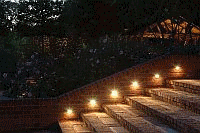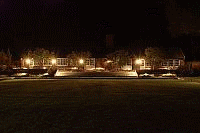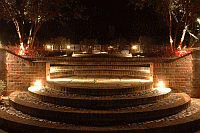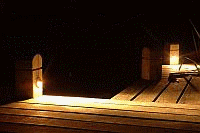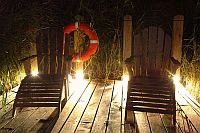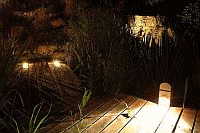Lighting Effects
Home » Lighting Effects
Outdoor or landscape lighting adds another dimension to the enjoyment of outdoor living. It enhances gardens, decks, buildings, trees and homes. Outdoor lighting adds character to the environment you live in, and entices you outside to take in the evening. Low voltage 12 volt lighting is an ideal and safe way to illuminate your surroundings. Halogen lamps give a white crisp light with good colour rendition and excellent lamp life up to 5000 hours.
If you are about to build a new home consider your lighting at the beginning of the project and not at the end where invariably you will have to make compromises and be disappointed with the result. With a little planning you will be able to enjoy all the wonderful lighting effects that are possible to create with our luminaires.
We offer six choices of lamp wattages (MR16) and beam angles as (shown below). This allows a greater range of effects to be produced by the luminaire. In most circumstances 20 watt lamps generate the desired effect in the garden or building highlighting, etc. A luminaire that uses a 20 watt lamp has three major advantages over a luminaire using a 50 watt lamp:
1. It will operate at a lower and safer temperature, and will not burn you.
2. The luminaire will use 60% less energy and therefore cost less to operate.
3. The luminaire will require less maintenance and lampholders will last much longer.
If you are about to build a new home consider your lighting at the beginning of the project and not at the end where invariably you will have to make compromises and be disappointed with the result. With a little planning you will be able to enjoy all the wonderful lighting effects that are possible to create with our luminaires.
We offer six choices of lamp wattages (MR16) and beam angles as (shown below). This allows a greater range of effects to be produced by the luminaire. In most circumstances 20 watt lamps generate the desired effect in the garden or building highlighting, etc. A luminaire that uses a 20 watt lamp has three major advantages over a luminaire using a 50 watt lamp:
1. It will operate at a lower and safer temperature, and will not burn you.
2. The luminaire will use 60% less energy and therefore cost less to operate.
3. The luminaire will require less maintenance and lampholders will last much longer.
A quality installation is imperative for the longevity of your outdoor lighting. We strongly recommend that time is taken when selecting an installer with experience in low voltage outdoor lighting systems.
Ensure the instructions supplied with each luminaire and transformer are followed meticulously to avoid failure. Halogen lamps generate significant heat and should be positioned carefully to avoid injury.
Hunza luminaires are a legacy for the future when installed correctly.
Ensure the instructions supplied with each luminaire and transformer are followed meticulously to avoid failure. Halogen lamps generate significant heat and should be positioned carefully to avoid injury.
Hunza luminaires are a legacy for the future when installed correctly.
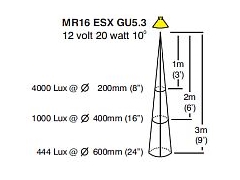
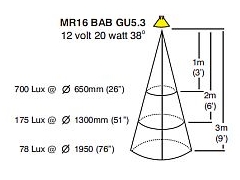
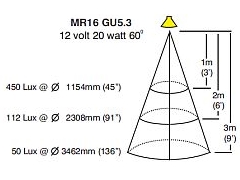
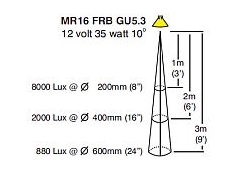
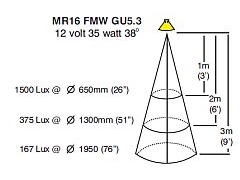
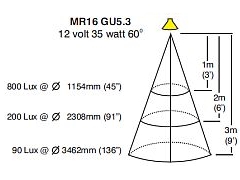
What you can light
Generally speaking, if you want to light something, you can with Hunza lights – architectural features, decks, tree trunks, lawns, leaves, flowers, fountains, ponds, pergolas, patios, paths…you name it.
Paint a picture with light and shade
When designing your scheme, try to think of it in its entirety, rather than as separate bits. All the elements should hang together and be in balance. Remember that things visible during the day can be left in darkness, so you have the opportunity to make dramatic changes to your visible landscape.
Less really is more
Shadow is as important to your scheme as light, so don’t try to light everything. Instead, retain some mystery. Also, keep it subtle – very bright garden lighting can look brash and artificial.
Hide your light under a bushel
Hunza lights are handsome, but ultimately it’s the lighting effect you want to see, not the fitting. So wherever possible, hide the light source – behind a shrub, perhaps, a rock, a pot or a wall.
Avoid glare
When it comes to garden lighting, there’s no razzle in dazzle. So try to angle the light beams away from your lines of sight. Where this isn’t possible, glare guards can reduce the dazzle factor.
Placing lights near plants
If you’re installing lights in winter, remember that your herbaceous plants will be growing in the summer. Try to avoid placing lights where they will be swamped by summer foliage.
Experiment with lighting effects
Try throwing shadows onto walls, creating reflections in ponds, or using backlighting to create interesting silhouettes. The possibilities are almost endless.
Wattage and beam angles
The wide choice of beam angles, Wattages, mounts and options such as frosted lenses means you can tailor each light source to create a precise effect. If you need to increase the beam throw of a lamp, try using a 20W lamp with a 10 deg. beam angle, rather than upgrading to a 35W or 50W lamp.
Coloured lamps?
Lamps are available in a variety of colours, although with less choice of Wattage and beam width. Used sparingly they can create interesting effects, but avoid the Las Vegas look.
Changing lamps
When you’re replacing a lamp, check it’s the right Wattage and beam angle. Avoid cheap lamps – they’re a false economy because they have shorter lives and need changing more often. We recommend using lamps with a rating of at least 5000 hours.
Keep your stainless steel stainless
If you opt for stainless steel fittings, regular washing to remove salt spray will prevent staining. There are also cleaning products especially for stainless steel.
Taking care of your cable
Black low voltage electrical cable is fairly invisible when placed on soil, but you can hide it by burying it in an inch or two of soil, or under a mulch. Keen gardeners might prefer to keep the cable visible to avoid accidentally damaging it when digging.
Installing your lighting scheme
We recommend using a qualified electrician to install your lighting, and make sure all the electrical circuits are protected by an RCD. Only use electrical equipment designed for exterior use with the appropriate IP rating, and please don’t even think about protecting equipment with plastic bags or temporary wrappings, rather than proper weatherproof enclosures.
Heat
Halogen light sources do generate a considerable amount of heat therefore precautions should be taken when considering their location, particularly at low level in public areas where children may come into contact. Normally there is always a solutions, therefore, if in doubt please contact your local Hunza distributor for advice.
 Tips & Tricks Guide
Tips & Tricks Guide
Generally speaking, if you want to light something, you can with Hunza lights – architectural features, decks, tree trunks, lawns, leaves, flowers, fountains, ponds, pergolas, patios, paths…you name it.
Paint a picture with light and shade
When designing your scheme, try to think of it in its entirety, rather than as separate bits. All the elements should hang together and be in balance. Remember that things visible during the day can be left in darkness, so you have the opportunity to make dramatic changes to your visible landscape.
Less really is more
Shadow is as important to your scheme as light, so don’t try to light everything. Instead, retain some mystery. Also, keep it subtle – very bright garden lighting can look brash and artificial.
Hide your light under a bushel
Hunza lights are handsome, but ultimately it’s the lighting effect you want to see, not the fitting. So wherever possible, hide the light source – behind a shrub, perhaps, a rock, a pot or a wall.
Avoid glare
When it comes to garden lighting, there’s no razzle in dazzle. So try to angle the light beams away from your lines of sight. Where this isn’t possible, glare guards can reduce the dazzle factor.
Placing lights near plants
If you’re installing lights in winter, remember that your herbaceous plants will be growing in the summer. Try to avoid placing lights where they will be swamped by summer foliage.
Experiment with lighting effects
Try throwing shadows onto walls, creating reflections in ponds, or using backlighting to create interesting silhouettes. The possibilities are almost endless.
Wattage and beam angles
The wide choice of beam angles, Wattages, mounts and options such as frosted lenses means you can tailor each light source to create a precise effect. If you need to increase the beam throw of a lamp, try using a 20W lamp with a 10 deg. beam angle, rather than upgrading to a 35W or 50W lamp.
Coloured lamps?
Lamps are available in a variety of colours, although with less choice of Wattage and beam width. Used sparingly they can create interesting effects, but avoid the Las Vegas look.
Changing lamps
When you’re replacing a lamp, check it’s the right Wattage and beam angle. Avoid cheap lamps – they’re a false economy because they have shorter lives and need changing more often. We recommend using lamps with a rating of at least 5000 hours.
Keep your stainless steel stainless
If you opt for stainless steel fittings, regular washing to remove salt spray will prevent staining. There are also cleaning products especially for stainless steel.
Taking care of your cable
Black low voltage electrical cable is fairly invisible when placed on soil, but you can hide it by burying it in an inch or two of soil, or under a mulch. Keen gardeners might prefer to keep the cable visible to avoid accidentally damaging it when digging.
Installing your lighting scheme
We recommend using a qualified electrician to install your lighting, and make sure all the electrical circuits are protected by an RCD. Only use electrical equipment designed for exterior use with the appropriate IP rating, and please don’t even think about protecting equipment with plastic bags or temporary wrappings, rather than proper weatherproof enclosures.
Heat
Halogen light sources do generate a considerable amount of heat therefore precautions should be taken when considering their location, particularly at low level in public areas where children may come into contact. Normally there is always a solutions, therefore, if in doubt please contact your local Hunza distributor for advice.
About Us
Bewdley Business Park
Long Bank, Worcestershire
DY12 2TZ
United Kingdom
+44 1299 269 950
Newsletter
Useful Links
Terms & Policies
Shortcuts
accessories
architectural
Bluetooth
bollard
brass
brick
Casambi
commercial
constant current
constant voltage
Cube
DALI
Dark Sky Range
dimming
down
drivers
floor
High Power
Hunza
insitu
lamps
linear
Liquid Beam
louvre
LuxR
M1
M2
M4
marine
micro
Moretti Luce
path
pole
pond
pool
RGBW
SLIM
solid cast bronze
spot
step
transformers
Ultra
up
wall
Translate Site






© 2025 Light Ideas International Ltd & Hunza Europe | Website by Altima

